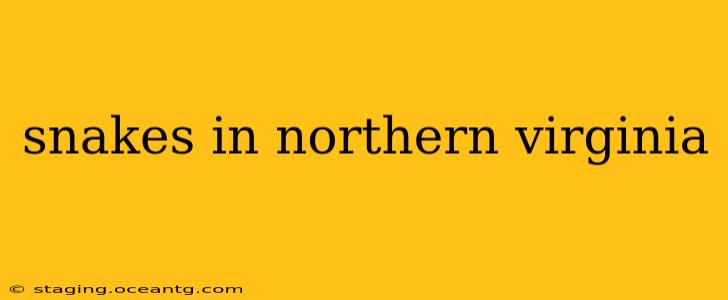Northern Virginia boasts a diverse ecosystem, and that includes a variety of snake species. Understanding these snakes, identifying them correctly, and knowing how to interact (or not interact!) with them is crucial for both human safety and the preservation of wildlife. This guide will explore the common snakes found in the region, addressing common questions and concerns.
What types of snakes are commonly found in Northern Virginia?
Northern Virginia is home to a range of non-venomous and venomous snakes. Common non-venomous species include:
- Northern Black Racer: These are long, slender, and typically black snakes known for their speed and agility. They are often mistaken for venomous snakes due to their size and coloring but are completely harmless to humans.
- Corn Snake: While not native, corn snakes are frequently found as escaped pets in Northern Virginia. They are docile and known for their beautiful patterns.
- Eastern Garter Snake: These are smaller, slender snakes with distinctive stripes. They are common throughout the region and are often found near water sources.
- Ring-necked Snake: These small snakes are easily identified by the yellow or orange ring around their neck. They are harmless and secretive.
- Northern Brown Snake: As their name suggests, they are brown and often mistaken for copperheads. However, they lack the distinctive hourglass pattern of copperheads and are non-venomous.
Venomous snakes in the area are less common but include:
- Copperhead: These are pit vipers with a distinctive hourglass-shaped pattern on their bodies. They are generally shy and prefer to avoid confrontation, but a bite can be dangerous and requires immediate medical attention.
- Timber Rattlesnake: These large, venomous snakes are less frequently encountered than copperheads but are still present in more wooded areas. Their rattle is a clear warning sign.
Are there poisonous snakes in Northern Virginia?
While the term "poisonous" is typically used for animals that inflict harm through toxins ingested (like a poison dart frog), the correct term for snakes that inflict harm through venom injected through fangs is venomous. Yes, Northern Virginia has venomous snakes, specifically copperheads and timber rattlesnakes. It's crucial to understand that encountering a venomous snake does not automatically mean a bite. Most snakebites occur when a snake feels threatened or cornered.
How can I identify a venomous snake in Northern Virginia?
Identifying venomous snakes requires careful observation. Key features to look for in copperheads and timber rattlesnakes include:
- Triangular head: Venomous snakes often have a broader head, distinctly set apart from their neck.
- Heat-sensing pits: Pit vipers (copperheads) have heat-sensing pits located between their eyes and nostrils.
- Distinct patterns: Copperheads have an hourglass-shaped pattern, while timber rattlesnakes have dark brown crossbands on a lighter background, and of course, the iconic rattle.
- Vertical pupils: Venomous snakes usually have elliptical or vertical pupils, unlike the round pupils of most non-venomous snakes.
Important Note: If you are unsure about a snake's identity, it's always best to assume it's venomous and avoid contact.
What should I do if I see a snake in Northern Virginia?
The best course of action when encountering a snake is to leave it alone. Give the snake plenty of space and avoid any sudden movements that might startle it. Do not try to kill or handle the snake. If you have children or pets, keep them away from the snake. If the snake is in a dangerous location (near a doorway or playground), contact your local animal control or wildlife removal service for assistance.
What should I do if I get bitten by a snake in Northern Virginia?
A snake bite is a medical emergency. If bitten:
- Remain calm. Panic can increase your heart rate and spread the venom.
- Remove any jewelry or tight clothing that may constrict blood flow.
- Clean the bite area with soap and water.
- Seek immediate medical attention. Try to remember the snake's appearance to help medical professionals identify the species and provide appropriate treatment. Do not apply a tourniquet or attempt to suck out the venom.
Where are snakes most likely to be found in Northern Virginia?
Snakes in Northern Virginia can be found in a variety of habitats, including:
- Wooded areas: Forests and wooded lots provide shelter and prey for many snake species.
- Near water sources: Many snakes, especially garter snakes, are found near streams, ponds, and marshes.
- Rocky areas: Snakes often seek shelter under rocks and logs.
- Fields and meadows: Open areas provide hunting grounds for some species.
This guide offers a general overview of snakes in Northern Virginia. For more detailed information on specific species, consult reputable resources like the Virginia Department of Wildlife Resources or local herpetological societies. Remember, responsible coexistence with wildlife requires knowledge and respect. By understanding these creatures, we can ensure both human safety and the preservation of Northern Virginia's rich biodiversity.
